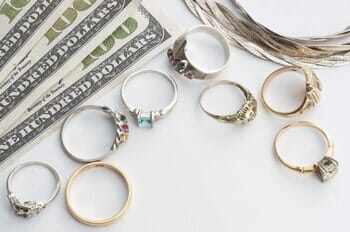The History Of The Pawn Shop In Sacramento
Origins Of The Pawnshop
As no economy or money-based society can prosper without any credit, pawnbroking has a long history in the eastern and western cultures.
In China, the business model existed some 3000 years ago, and over time, imperial authorities have strictly regulated it.
In Hong Kong, the practice follows the Chinese tradition. As a security measure, the counter is usually taller than the average person so that a customer can hold up his/her hand to offer their collateral. There may be a wooden screen between the door and the counter to protect the customer's privacy. The symbol of a pawn shop in Hong Kong is a bat (signifying fortune) holding a coin (signifying benefits).

In Japan, the usual symbol for a pawn shop is a circled digit seven, because “shichi,” the Japanese word for seven, sounds similar to the word for “pawn.”
In India, between the 9th and 6th century B.C., the Marwari Jain community pioneered the pawn-broking business. Today, the job is done by many agents called “saudagar.” However, instead of working from a shop, they may go to people's homes to solicit offers.
In Thailand, pawnbroking is also a tradition where pawnshops are run both privately and by local governments.
The Western pawn culture dates back to the Greek and Roman times. Both Greece and Rome were familiar with the operation of pawning; actually, it is from the Roman jurisprudence that most of the contemporary law on the subject is derived. The chief difference between Roman and English law is that under Roman law, certain things, such as apparel, furniture, and tools of the trade, could not be pledged, whereas there is no such restriction in English legislation. Emperor Augustus converted the surplus from the confiscated property of criminals into a fund from which sums of money were lent, without interest, to those who could pledge valuables equal to double the amount borrowed.
A Christian prohibition on profit from money “without working” made banking sinful. Though Pope Leo the Great forbade charging interest on loans by canon law, it was not forbidden to take collateral on loans. Pawn shops operated on the basis of a contract that fixed in advance the “fine” for not respecting the nominal term of the “interest-free” loan or, alternatively, may structure a sale-repurchase by the “borrower” where the interest is implicit in the repurchase price. Similar conventions exist in modern Islamic banking.
Christianity and Judaism banned usury but allowed it toward heretics. Thus, Christians could lend to Jews and vice versa. The only requirement for a young man who desired a future in the financial world of the Middle Ages was that he needed to be able to read and write. The methods used for bookkeeping were carefully kept within families and slowly spread along trade routes. This knowledge was available to Jesuits and Jews, who consequently played a major role in European finance. Generally, the Jesuits took the role of go-between with heads of state while the Jews manned the low-end pawnshops. It comes as no surprise that the pawn shops of Rome were the most prosperous of all, especially in the 15th century under Popes Pius IV and Sixtus V.
The Medici families in Italy along with the Lombards in England were moneylenders in Europe. Legend has it that one of the Medicis in the employ of Emperor Charles the Great fought a giant and slew him with three sacks of rocks. The three balls or globes later became part of their family crest and ultimately the sign of pawnbroking.
Three Globes
This Italian “Lombard” pawn shop method became famous and had a name for reliability and honesty.
In 1492, Ferdinand and Isabella of Spain signed a decree expelling all Jews who refused to be converted to Christianity. A considerable number moved into Portugal. Many members of the migrant Jewish community in Portugal proceeded to become wealthy in commercially successful Portuguese port cities. Being forced on the move, Jewish families remained mobile and quickly developed international family agencies for growing brokerage houses involved with shipping. Such family networks of mobile Jewish “Lombards” migrated from port city to city with the Spanish Inquisition and created international networks. In France, the Lombards became synonymous with the Cahorsins. Most European cities still have a street named Lombard St. after the pawn shop that once housed there. In Dutch, the name for a pawn shop is still “lommerd,” and the same etymology persists in the names of various banks (unless named after some family). In Polish and Russian, a pawn shop is called simply “Lombard.”
The near-monopoly position of the Jewish Lombards in finance became less prominent as various Protestant factions after the Reformation became just as persecuted as the Jews. In the 18th century, many bankers and shipping agents were Quakers. Though the pawnshops were no longer manned by Jews and/or Jesuits, they were more and more often called Lombard houses, and most major port cities still have a Lombard St. or Lombard Alley today. American examples include San Francisco, New Orleans, Boston, Baltimore, and Philadelphia. The term “Lombard” for pawnshop (or pawnshop owner) was in use well into the late 18th century; thus, many of these streets were named with the establishment of shipping agents in those towns.
The religious restrictions made banking seem immoral, and Lombard bankers were often considered undesirable company. These prejudices were the reason that banking families intermarried and kept to themselves, resulting in international dynasties of banking families. The story of Mary Poppins illustrates how banking was still considered immoral by some in the 20th century, though in the business world, it was by that time a perfectly respectable profession.
